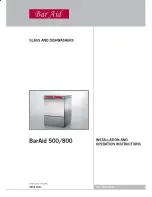
6 720 680 223
Troubleshooting
39
heater. Then open all of the hot water taps served by
the heater. Wait 10 minutes and check all taps for
water flow. There should be no water flowing. Any
continuous flow of water, small or large, indicates a
crossover and must be corrected. Consult a
professional plumber for help in correcting a
crossover. Failing single lever faucets and mixing
valves are common causes of plumbing crossovers.
8. Ensure the outlet temperature sensor is making
contact and firmly mounted on the hot water pipe.
7.5
Low water flow/pressure
1. Too many hot water applications are being used
simultaneously or too much flow is demanded. The
water heater will effectively support two 2.0-2.5
GPM shower heads simultaneously or multiple sink
applications. Greater draws will result in a water
pressure drop and reduced flow at taps.
2. Ensure that gas pressure is in accordance with
specifications in chapter 3.12, page 26. A gas
pressure reading is needed to proceed further.
Contact your original installer or a local certified gas
technician to obtain this reading. If gas pressure is
inadequate, the water heater will close its motorized
water valve, reducing the hot water flow rate in an
attempt to reach the selected output temperature.
3. If selected temperature on the unit is set too high for
the demanded flow rate, the water heater will close
its motorized water valve, reducing the hot water flow
rate in an attempt to reach the selected output
temperature. Lowering the selected temperature will
allow the motorized water valve to open up for
increased water flow rate.
4. Clean inlet filter screen per chapter 6.1, page 32.
5. Inspect the water path for obstructions. Make sure all
showerheads, faucet aerators and whole house
filters are clear of debris.
7.6
Hot water temperature fluctuates
at tap
1. Hot water is very hot out of the tap, requiring mixing
of cold water in order to attain a useable hot water
temperature. The addition of too much cold water will
overpower the hot water flow from the tankless water
heater.
This slows the flow within the tankless water heater,
decreasing it below activation point, which shuts off
the burners. The end result is nothing but cold water
coming out of the outlet.
Consult www.boschhotwater.com for a detailed
service bulletin on overcoming temperature
fluctuations.
2. Unbalanced pressure in water lines. Any restriction in
the water heater, such as a clogged inlet filter screen,
can result in unequal pressures between the cold
and hot water lines. In such cases, when mixing in the
higher pressure cold water at the tap, the lower
pressure hot water can be overpowered. This will
shut down the burners because the hot water flow
rate fell below the minimum flow rate required for
activation. Verify inlet filter screen is clean and clear
of debris. See chapter 6.1, page 32 for inlet filter
cleaning instructions.
3. Heater deactivated by temperature balancing valves.
If the outlet water temperature is set too high, the
heater can produce temperatures that are too hot. A
temperature balance shower valve will automatically
mix in cold water to reduce the hot water
temperature. In the event of any temperature
instability at a fixture using a temperature balancing
valve, refer to the valve manufacturer for instructions
on internal adjustment setting. An adjustment should
be made to minimize the amount of cold water the
valve is adding. Additionally, the temperature setting
on the heater can be lowered to prevent the
temperature balance valve from mixing in too much
cold water.
4. Inlet water pressure is erratic due to fluctuating
supply water pressure. For installation on a private
well system with the use of a pressure tank, the
lowest pressure range setting recommended is 40-
60 psi (2.75 - 4.15 bar). Consult your installer or
local plumber for effective ways to maintain constant
water pressure to the water heater when on a well
system.
7.7
Noisy burner/heater during
operation
1. Sealed combustion leak. Make sure combustion
cover is securely fastened. Ensure the exhaust vent
adaptor is properly sealed with supplied gasket.
Leaky seals create improper combustion resulting in
noise.
2. Improper venting. Venting that is unsealed, the wrong
material, too big in diameter or too long in run will
result in unstable burner flames and noise. Ensure
venting is proper and in accordance with
specifications in chapter 3.3, page 9.
3. Lack of adequate combustion air. Drawing
combustion air from a room area of inadequate size
will result in unstable burner flames and noise.
Improper use of piping for combustion air will result
in unstable burner flames and noise. Ensure
adequate combustion air is provided to the unit in
accordance with specifications in Section 3.4, page
20, Combustion Air Requirements.
4. Cross contamination. Ensure that intake and exhaust
terminations maintain minimum required clearances
stated in the manual. Cross contamination between
intake and exhaust may cause unstable burner flames
and noise.
















































